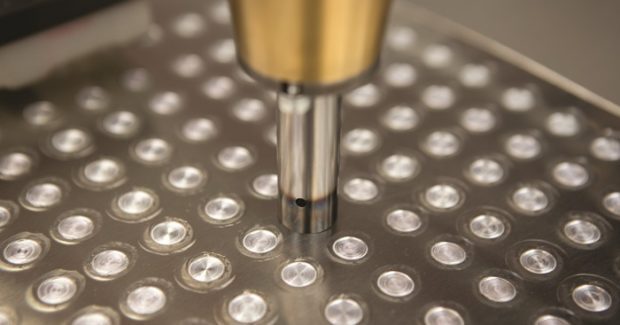Friction Stir Spot Welding of Aluminum and Other Lightweight Materials
The SpotMeld system from Coldwater Machine can weld lightweight materials such as aluminum, magnesium, non-ferrous and dissimilar sheet material without adding additional weight to the structure, producing a weld that is near original material strength.
Posted: August 25, 2018
In Booth A-3251, Coldwater Machine Company (Coldwater, OH) will highlight their SpotMeld™ Refill Friction Stir Spot Weld (RFSSW) system, focusing on the joining of aluminum sheet materials. This system can weld lightweight materials, such as aluminum (1000 series to 7000 series), magnesium, non-ferrous and dissimilar sheet material. It provides an alternative to single-point joining processes like resistance spot welding, laser welding and riveting without adding additional weight to the structure, and it produces a weld that is near original material strength. The SpotMeld system can currently join a stack-up of materials from 0.8 mm to 8 mm, weld dissimilar aluminums in one stack and join multiple sheets across the edge of a panel. One example used three sheets of 3.0 mm 6000 series aluminum and one sheet of 1.5 mm 5000 series aluminum.
These friction stir spot welders can be configured to application specifics and mounted on any industrial robot. A variety of weld recipes can be used on demand by the robot controller, which results in a very flexible production system. The SpotMeld RFSSW process consists of five phases:
- Weld head closing.
- Friction Phase – Both the pin and sleeve are placed on the surface of upper sheet and rotate to generate sufficient frictional heat for plunging.
- Advance Phase – Sleeve advances into materials and pin retracts, pulling softened material from the metal sheets into the tool.
- Retract Phase – Sleeve retracts and pin advances flush with sleeve, pushing displaced material back into the hole and forging the finished weld.
- Weld is complete, weld head opens.
A major advantage of this approach is that the tool doesn’t fully penetrate through the bottom sheet, leaving a smooth surface with potential for use on exterior body panels. Other benefits include a small heat affected zone, consistency in weld duplication and faster weld times, as well as being environmentally cleaner and safer with no filler material, spatter, smoke, radiation or shield gases.
Coldwater Machine Company, 911 North 2nd Street, Coldwater, OH 45828-8736, 419-678-4877, www.coldwatermachine.com.




